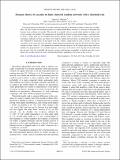Dynamic theory of cascades on finite clustered random networks with a threshold rule
Author(s)
Whitney, Daniel E.
DownloadWhitney-2010-Dynamic theory of ca.pdf (762.5Kb)
PUBLISHER_POLICY
Publisher Policy
Article is made available in accordance with the publisher's policy and may be subject to US copyright law. Please refer to the publisher's site for terms of use.
Terms of use
Metadata
Show full item recordAbstract
Cascade dynamics on networks are usually analyzed statically to determine existence criteria for cascades. Here, the Watts model of threshold dynamics on random Erdős-Rényi networks is analyzed to determine the dynamic time evolution of cascades. The network is assumed to have a specific finite number of nodes n and is not assumed to be treelike. All combinations of threshold ϕ, network average nodal degree z, and seed sizes |S| from a single node up are included. The analysis permits study of network size effects and increased clustering coefficient. Several size effects not found by infinite network theory are predicted by the analysis and confirmed by simulations. In the region of ϕ and z where a single node can start a cascade, cascades are expanding, in the sense that each step flips a larger group than the previous step did. We show that this region extends to larger values of z than predicted by infinite network analyses. In the region where larger seeds are needed (size proportional to n), cascades begin by contracting: at the outset, each step flips fewer nodes than the previous step, but eventually the process reverses and becomes expanding. A critical mass that grows during the cascade beyond an easily-calculated threshold is identified as the cause of this reversal.
Date issued
2010-12Department
Massachusetts Institute of Technology. Engineering Systems DivisionJournal
Physical Review E
Publisher
American Physical Society
Citation
Whitney, Daniel E. “Dynamic Theory of Cascades on Finite Clustered Random Networks with a Threshold Rule.” Physical Review E 82.6 (2010): p. 066110-066110 © 2010 The American Physical Society.
Version: Final published version
ISSN
1539-3755
1550-2376